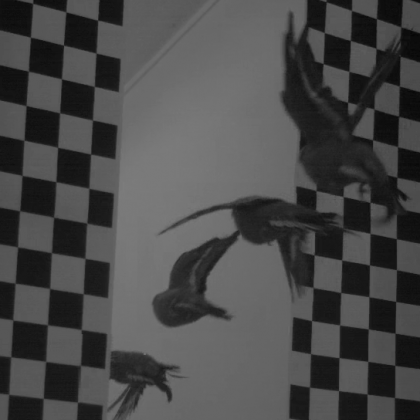Bird brains more precise than humans'

(Phys.org) —Birds have been found to display superior judgement of their body width compared to humans, in research to help design autonomous aircraft navigation systems.
A University of Queensland (UQ) study has found that budgerigars can fly between gaps almost as narrow as their outstretched wingspan rather than taking evasive measures such as tucking in their wings.
UQ Queensland Brain Institute researcher Dr Ingo Schiffner said previous research showed humans unnecessarily turned their shoulders to pass through doorways narrower than 130 per cent of their body width, whereas birds are far more precise.
"We were quite surprised by the birds' accuracy – they can judge their wingspan within 106 per cent of their width when it comes to flying through gaps," Dr Schiffner said.
"When you think about the cluttered environments they fly through, such as forests, they need to develop this level of accuracy.
"When they encounter a narrow gap, they either lift their wings up vertically or tuck them in completely, minimising their width to that of their torso," he said.
The researchers wanted to know precisely how birds judge gaps between obstacles before engaging in evasive manoeuvres.
In testing, budgies flew down corridors with variable widths between obstacles, and their flights were recorded with high-speed cameras for analysis.
Dr Schiffner said the research would be applied to robotics work at the Queensland Brain Institute's Neuroscience of Vision and Aerial Robotics laboratory.
"If we can understand how birds avoid obstacles, we might be able to develop algorithms for aircraft to avoid obstacles as well," he said.
"For instance, urban drones used for deliveries would need to fly through complex environments such as tight alleyways or between trees at the front of homes.
"For us, it isn't the ability to tuck in wings that is of interest if we are talking about fixed-wing or rotor aircraft, but whether we can replicate what happens neurologically in birds as they navigate."
To judge airspeed, budgies use optic flow – the rate visual cues pass by the eyes. They do not see three-dimensionally like humans, due to the lateral placement of their eyes and lack of binocular overlap.
"Seeing in three dimensions requires two eyes or cameras with sufficient visual overlap, so using optic flow with just one camera would be very useful, saving weight and keeping autonomous vehicles small."
The paper, Minding the gap: In-flight body awareness in birds, is published in Frontiers in Zoology.
More information: The complete study is available online: www.frontiersinzoology.com/content/11/1/64
Journal information: Frontiers in Zoology
Provided by University of Queensland

















